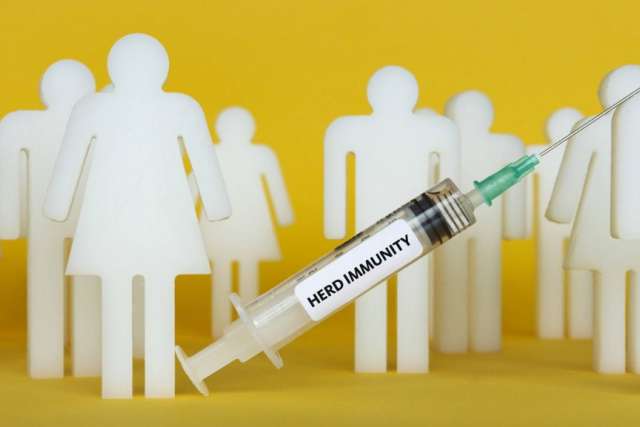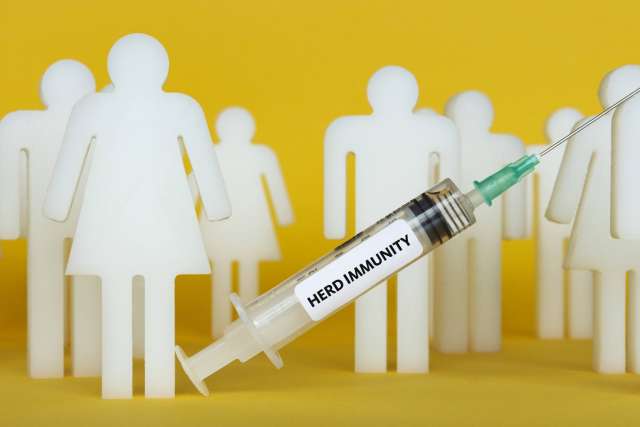You’ve probably heard about “herd immunity” — when a large enough percentage of the population is immune to a disease that it ceases to spread — as a key to ending the COVID-19 pandemic. If the bulk of the herd has immunity, either through vaccination or infection, even those who can’t be vaccinated will be protected. Without available hosts, the disease has nowhere to go.
But in the face of an easily transmissible virus that has ravaged the globe, killing more than 3 million people internationally and infecting 140 million more to date, what constitutes the herd?

“It’s a complicated question,” says Annabelle de St. Maurice, MD, MPH, co-chief infection prevention officer at UCLA Health. “It has to be global, because if you have travelers who are coming in and portions of your population who aren't vaccinated, then those people are at risk. And it has to be universal. If you have pockets of people who aren’t immunized, that can really create a large problem.”
Early in the pandemic, herd immunity was presented as a goal, though experts quibbled over the exact percentage of the population required to confer protection to the whole. Anthony Fauci, MD, the nation’s top infectious disease expert, said at a recent news conference that he “would like to get away from this concept of referring to something that is very elusive in its definition. Because we don’t know what herd immunity percentage (is) …
“We’ve made estimates that it’s somewhere between 70 and 85%, but we don’t know that as a fact,” he said. “So rather than concentrating on an elusive number, let’s get as many people vaccinated as quickly as we possibly can.”
Vaccine accessibility is expanding across California and the country. About 43% of Californians have received at least one dose and 26% are fully vaccinated, according to the Los Angeles Times. The national numbers are similar, with 40% of Americans having received at least one dose and 26% fully vaccinated, according to a New York Times tally.
Vaccines continue to roll out internationally, as well, though availability and uptake vary widely by country, with some nations yet to report administering a single dose. In Mexico, 3.5% of the population is fully vaccinated, to date. In Canada, it’s 2.5%; in South Africa, it’s 0.5%.
The Pfizer and Moderna vaccines require two doses; the Johnson & Johnson vaccine is one dose.
When it comes to achieving herd immunity, “there is no real magic number,” says Robert Kim-Farley, MD, MPH, a professor of epidemiology and community health sciences at the UCLA Fielding School of Public Health.

“I think probably around 80% with the current transmissibility of COVID-19 is probably a good target to try to reach for immunity,” Dr. Kim-Farley said in a recent interview. “But I think you have to realize that some of these variants are becoming more transmissible. The more transmissible the disease is, the higher the vaccination rate has to be to achieve the same level of reduction in disease.”
Availability of vaccines isn’t the only issue. Lack of vaccine acceptance also slows progress toward herd immunity, Dr. de St. Maurice says.
“If more people are vaccine-hesitant, that increases the amount of time until we achieve herd immunity,” she says. “That’s why it’s really important to provide the facts and answer questions and encourage more people to choose to get vaccinated.”
Because no vaccine is 100% effective, greater circulation of disease can increase the incidence of infection occurring even in those who are fully vaccinated. And as long as the virus continues to spread, it continues to evolve, possibly into variants that are more transmissible, which further increases risk to both those who’ve been vaccinated and those who haven’t.
Without herd immunity, the potential for surges and large outbreaks remains, Dr. de St Maurice says.
Travel between states or countries with varied vaccination rates can also compromise herd immunity and lead to disease spread, she says, noting that international travel was implicated in recent measles outbreaks in the U.S.

“If you’re coming from a place where there are fewer vaccines, then the likelihood of getting COVID is higher,” she says. “Because you're coming from an area where fewer people are vaccinated, you are more likely to be exposed because there's more circulation of the virus. And then when you travel you can spread it to others.”
Despite ongoing vulnerability to this global pandemic, the likelihood of unchecked viral spread in a given county, state or country decreases when a greater proportion of its population has immunity to COVID-19. The U.S. Centers for Disease Control and Prevention finds breakthrough infections are rare. Of more than 75 million fully vaccinated Americans, 5,814 breakthrough COVID-19 cases have been reported.
“If we had really high vaccine rates, the number of outbreaks that we would experience would be a lot lower,” Dr. de St. Maurice says. “But we really need to have a global effort, too, to eradicate this disease.”
Related articles
Remote workers prepare for return to a different kind of office space as pandemic eases
COVID-19 vaccine eligibility is rapidly expanding - here's why it's time to get yours
COVID-19: Track the latest developments and look back at how the pandemic evolved




